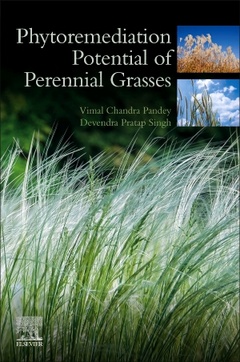Description
Phytoremediation Potential of Perennial Grasses
Authors: Pandey Vimal Chandra, Singh D.P.
Language: English
Subject for Phytoremediation Potential of Perennial Grasses:
126.84 €
In Print (Delivery period: 14 days).
Add to cart392 p. · 15x22.8 cm · Paperback
Description
/li>Contents
/li>Readership
/li>Biography
/li>Comment
/li>
Phytoremediation Potential of Perennial Grasses provides readers with the knowledge to select specific perennial grass species according to site-specific needs. In addition, it demonstrates the potential opportunities for grass-based phytoremediation to yield phytoproducts, especially biomass-based bioenergy and aromatic essential oils as a green economy while in the process of remediating contaminated sites. The book brings together recent and established knowledge on different aspects of grass-based phytoremediation, providing this information in a single source that offers a cutting-edge synthesis of scientific and experiential knowledge on polluted site restoration that is useful for both practitioners and scientists in environmental science and ecology.
1: Perennial grasses in phytoremediation—challenges and opportunities
2: Vetiveria zizanioides (L.) Nash— more than a promising crop in phytoremediation
3: The potential of sewan grass (Lasiurus sindicus henr.) in phytoremediation—an endangered grass species of desert
4: Miscanthus–a perennial energy grass in phytoremediation
5: Phragmites species – promising perennial grasses for phytoremediation and biofuel production
6: Feasibilty of festuca rubra L. native grass in phytoremediation
7: Reed canary grass (Phalaris arundinacea L.)–Coupling phytoremediation with biofuel production
8: Switchgrass–an asset for phytoremediation and bioenergy production
9: Cymbopogon flexuosus–an essential oil-bearing aromatic grass for phytoremediation
10: Saccharum spp.—potential role in ecorestoration and biomass production
11: Bermuda grass—Its role in ecological restoration and biomass production
12: Moso bamboo (Phyllostachys edulis (Carrière) J.Houz.)–One of the most valuable bamboo species for phytoremediation
13: The application of Calamagrostis epigejos (L.) Roth. in phytoremediation technologies
14: Potential of napier grass (Pennisetum purpureum Schumach.) for phytoremediation and biofuel production
15: Role of microbes in grass–based phytoremediation
16: Case studies of perennial grasses—Phytoremediation (holistic approach)
Dr. Singh is Professor of Environmental Science and past director of the USIC at Babasaheb Bhimrao Ambedkar (Central) University, Lucknow, Uttar Pradesh, India. He completed his Post-doctoral Research from University College of Swansea, U.K. His research area is bioremediation and phytoremediation of contaminated sites. His research highlighting the transformation of waste into useful product by using biological resources deserves special attention as it is considered future technology for sustainable environmental development. Dr. Singh has published his research findings in international peer-reviewed journals. He has had 101+ research publication in reputed journals, 28 book chapters, and five books.
- Provides a holistic approach to grass-based phytoremediation, covering the ecological, economic and social issues related to its management
- Addresses the key role that grass-based phytoremediation plays in maintaining ecosystem services in polluted sites
- Includes strategies to mitigate costs related to the phytoremediation of polluted sites
These books may interest you

Phytomanagement of Fly Ash 116.98 €



